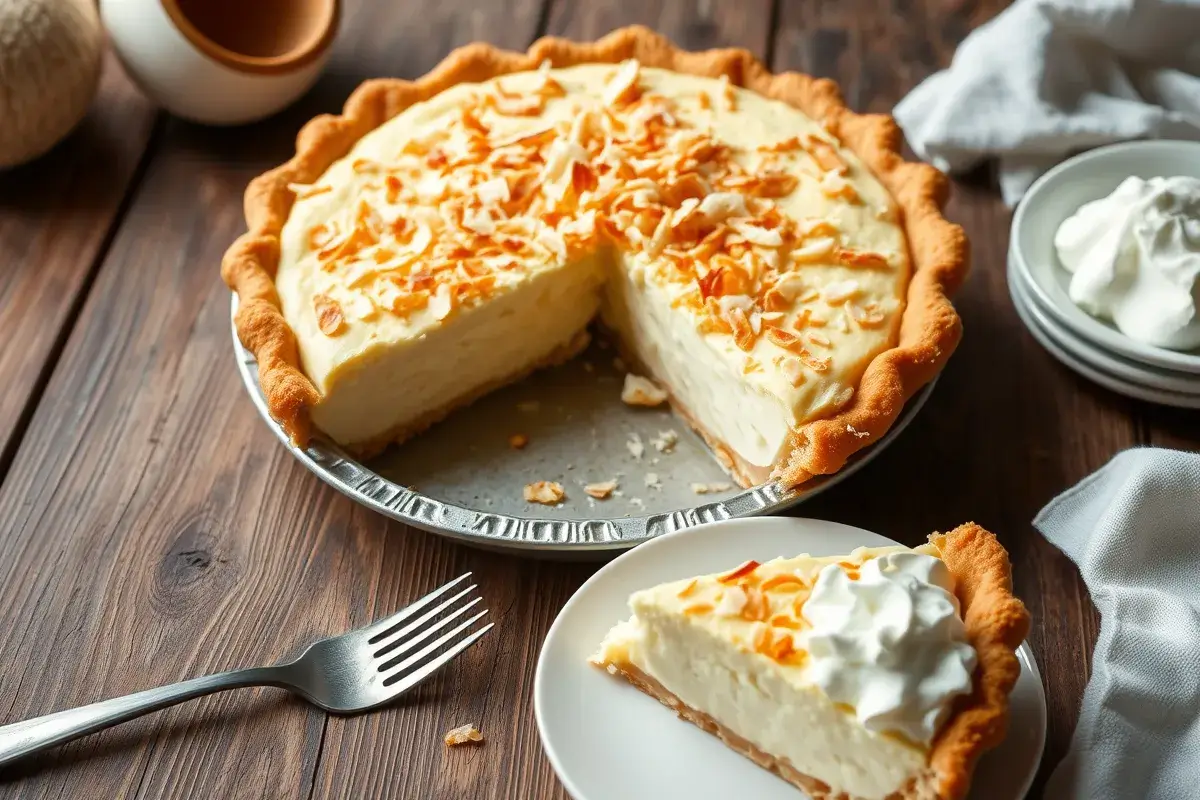Coconut custard pie is a timeless dessert that combines the rich, creamy texture of custard with the tropical sweetness of coconut. Whether you’re looking to impress guests at a holiday gathering or satisfy your sweet tooth, this pie is sure to be a hit. The combination of coconut milk, shredded coconut, and eggs creates a custard filling that is both smooth and flavorful, all nestled in a perfectly flaky pie crust.
In this step-by-step guide, we’ll show you how to make the best coconut custard pie from scratch, covering everything from the ingredients you’ll need to the baking techniques that will help you achieve a perfectly golden crust and creamy filling. Whether you’re an experienced baker or a beginner, this recipe is simple to follow and guaranteed to deliver delicious results every time. So, let’s get started and create the perfect coconut custard pie for your next celebration or family gathering!
What You’ll Need to Make Coconut Custard Pie
To make the best coconut custard pie, you’ll need a few simple ingredients and essential baking tools. The key to a delicious coconut custard pie lies in using quality ingredients, so let’s go over everything you’ll need, including detailed measurements.
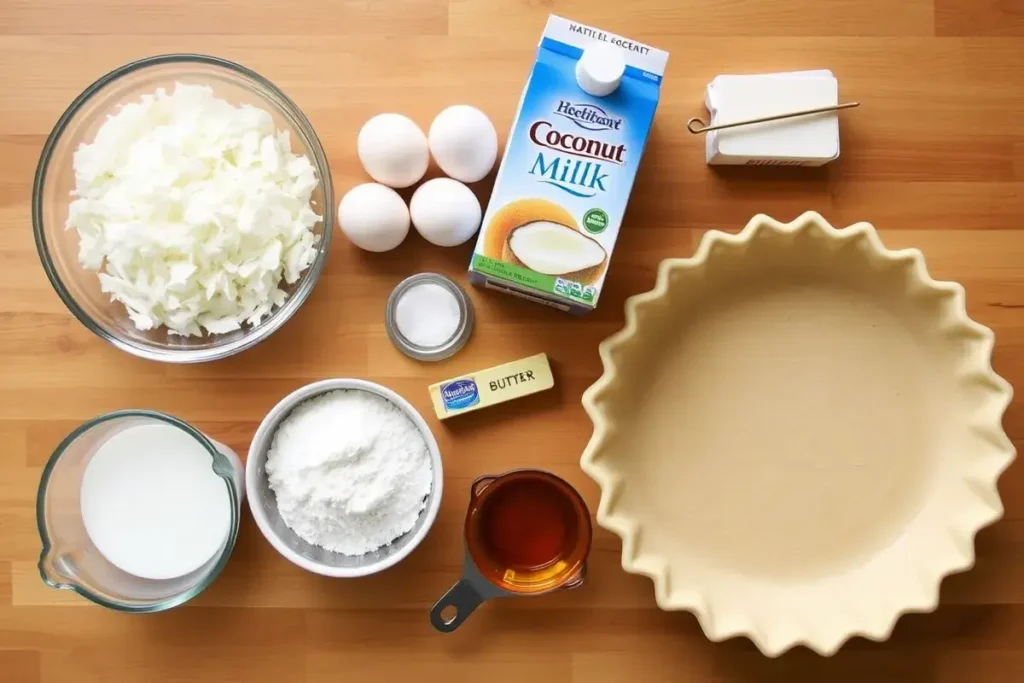
Essential Ingredients:
- Shredded Coconut (unsweetened):
- Measurement: 1 ½ cups
- Why It’s Important: Shredded coconut provides texture and a rich coconut flavor to the custard. Using unsweetened coconut ensures your pie isn’t overly sweet, letting the natural flavors shine.
- Eggs:
- Measurement: 4 large eggs
- Why It’s Important: Eggs are the base of the custard filling, helping to thicken it and give it that smooth, creamy consistency.
- Granulated Sugar:
- Measurement: ¾ cup (150 grams)
- Why It’s Important: Sugar adds sweetness to balance the coconut’s natural flavor. It also helps to create a rich, smooth custard texture.
- Coconut Milk:
- Measurement: 1 ½ cups (full-fat coconut milk)
- Why It’s Important: Coconut milk brings that distinctive coconut flavor and contributes to the richness of the custard. Be sure to use full-fat coconut milk for the best results, as it ensures a creamy texture.
- Whole Milk:
- Measurement: 1 cup
- Why It’s Important: Whole milk lightens the rich coconut milk and creates the perfect balance in the custard. If you want a more decadent pie, you can use heavy cream or a mix of cream and milk.
- Vanilla Extract:
- Measurement: 1 teaspoon
- Why It’s Important: A touch of vanilla extract complements the coconut flavor, adding depth and warmth to the custard.
- Salt:
- Measurement: ¼ teaspoon
- Why It’s Important: A pinch of salt helps to enhance the overall flavor and balance the sweetness of the coconut and sugar.
- Cornstarch (optional for thicker filling):
- Measurement: 1 tablespoon
- Why It’s Important: If you prefer a thicker custard, cornstarch can be added to help the filling set perfectly. It’s optional but can be helpful if you want a firmer consistency.
Pie Crust Options:
For the crust, you can either make a homemade pie crust or use a store-bought option for convenience.
- Homemade Pie Crust:
- Ingredients:
- 1 ¼ cups all-purpose flour
- ½ teaspoon salt
- ½ cup unsalted butter, cold and cut into small cubes
- 4-5 tablespoons ice water
- Why It’s Important: A homemade pie crust will be flaky and buttery, providing a perfect base for the creamy coconut custard. You can prepare the crust ahead of time, so it’s ready to go when it’s time to assemble the pie.
- Ingredients:
- Store-Bought Pie Crust:
- Measurement: 1 standard 9-inch pie crust
- Why It’s Important: If you’re short on time or don’t want to make your own crust, a store-bought pie crust works just fine. Choose a high-quality option for the best results.
Baking Tools:
To make the coconut custard pie, you’ll also need a few key tools to make the process smooth and efficient:
- 9-inch Pie Dish:
- A standard 9-inch pie dish works best for this recipe. If you prefer a thicker filling or crust, you could use a smaller dish, but adjust the baking time accordingly.
- Mixing Bowls:
- You’ll need a medium-sized bowl to whisk together the custard ingredients, as well as a larger bowl for mixing the pie crust ingredients if you’re making it from scratch.
- Whisk:
- A whisk will help you mix the custard ingredients together and ensure a smooth texture without lumps.
- Measuring Cups and Spoons:
- Precise measurements are key to a perfectly balanced coconut custard pie, so be sure to have measuring cups and spoons on hand.
- Oven Thermometer (optional but helpful):
- To ensure your oven is at the correct temperature, an oven thermometer can help you avoid undercooking or overcooking the pi
How to Prepare the Coconut Custard Filling
The coconut custard filling is the heart of this pie, offering a creamy, indulgent texture with the perfect balance of sweetness and coconut flavor. Here’s a detailed breakdown of how to make the best coconut custard filling:
Making the Custard Base
The foundation of the coconut custard filling starts with a custard base made from a combination of eggs, sugar, and coconut milk. Begin by whisking together the eggs and sugar in a large mixing bowl. The eggs act as the binding agent that will create the smooth, rich texture of the custard, while the sugar sweetens the pie to perfection.
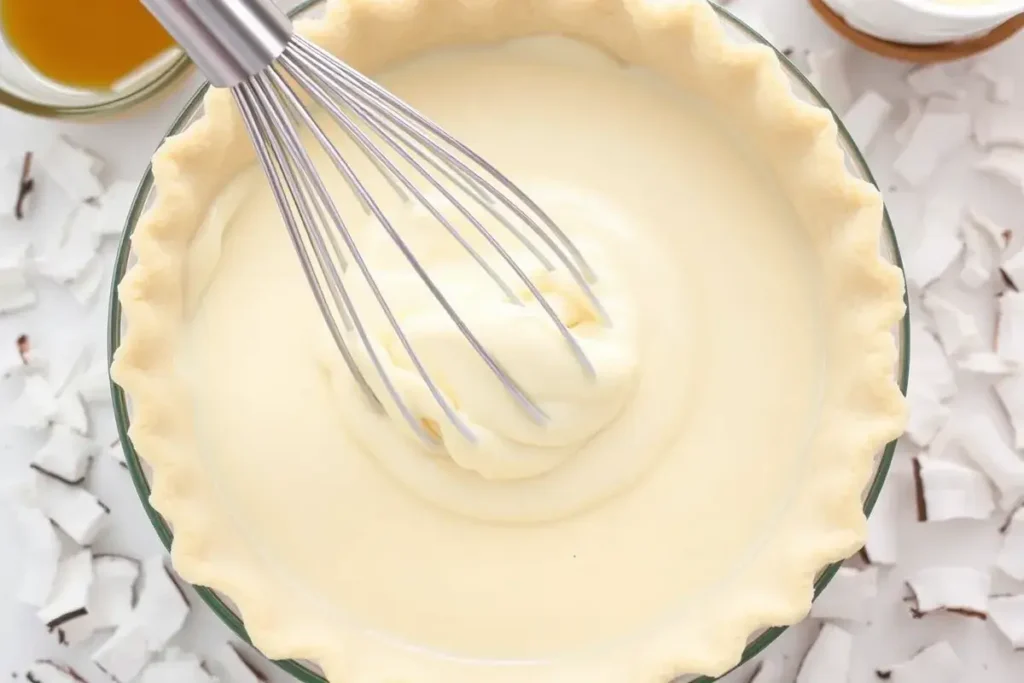
Once the eggs and sugar are well combined, it’s time to incorporate the coconut milk. Coconut milk adds the tropical, creamy flavor that makes this pie stand out. Be sure to use full-fat coconut milk for the richest, most flavorful custard. Slowly pour the coconut milk into the egg mixture while stirring constantly to avoid curdling the eggs. This gradual process ensures the ingredients blend smoothly together without any lumps.
Adding the Coconut Flavor
To enhance the coconut flavor, stir in shredded coconut. Choose unsweetened shredded coconut to keep the pie from becoming overly sweet. You can use either finely shredded or medium-shredded coconut, depending on your texture preference. The coconut will not only flavor the custard but also add a bit of texture and chewiness, making each bite satisfying.
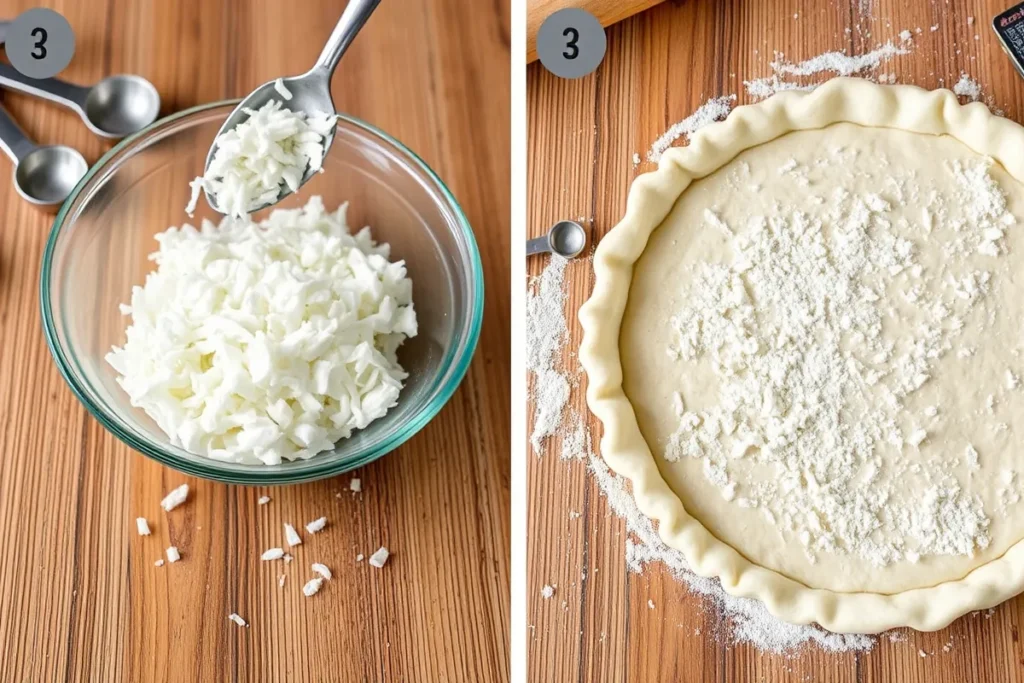
For an added depth of flavor, consider adding a teaspoon of vanilla extract. The vanilla complements the coconut beautifully, rounding out the taste and providing a subtle sweetness that enhances the overall flavor of the custard.
Achieving the Perfect Custard Consistency
Cooking the custard is a delicate process—too much heat can cause the eggs to scramble, while not enough heat can result in a runny filling. The goal is to achieve a smooth, thickened custard that will hold its shape when baked. To do this, cook the mixture over medium heat, stirring constantly. You’ll want to keep an eye on the consistency; once it reaches a pudding-like thickness, it’s ready to be poured into the prepared pie crust.
It’s essential to continuously stir the custard while cooking to prevent any clumps from forming. A wooden spoon or heat-resistant silicone spatula works best for this, as it allows you to scrape the sides and bottom of the pan, ensuring even heat distribution. When the custard thickens, it should coat the back of the spoon, and you should be able to draw a line through it with your finger.
Once the custard reaches the desired consistency, remove it from the heat. Allow it to cool for a few minutes before pouring it into the prepared pie crust. This will help the custard set properly during baking and ensure a smooth texture.
The Best Pie Crust for Coconut Custard Pie
The crust is just as important as the custard when it comes to making a memorable coconut custard pie. A flaky, buttery pie crust provides the perfect balance to the creamy, sweet coconut filling. Whether you choose to make your own pie crust from scratch or opt for a store-bought version, getting the right crust is essential to achieving a perfect coconut custard pie.
Flaky Homemade Pie Crust Recipe
For the best results, a homemade pie crust offers the freshest flavor and texture. The key to a perfectly flaky crust is keeping the ingredients cold and handling the dough gently. Here’s how to make it:
- Ingredients: You’ll need all-purpose flour, salt, unsalted butter, and ice water. The cold butter is crucial to creating flaky layers, so make sure to cut it into small cubes and keep it chilled until ready to use.
- Process: In a large bowl, mix the flour and salt. Add the cold butter and cut it into the flour using a pastry cutter or your hands until it forms pea-sized pieces. Gradually add ice water, one tablespoon at a time, and mix until the dough starts to come together.
- Chill the Dough: After forming the dough, wrap it in plastic wrap and refrigerate for at least 30 minutes. This step helps the dough relax and ensures that the crust will hold its shape during baking.
- Rolling Out the Dough: Roll the dough on a lightly floured surface to fit your pie dish. Be careful not to overwork the dough, as this can make it tough. Once rolled, place it in the pie dish and trim any excess dough around the edges.
Store-Bought Pie Crusts
If you’re short on time or prefer convenience, store-bought pie crusts can be a great option. Look for a high-quality, all-butter crust or a refrigerated dough that you can roll out. These varieties tend to provide a better flavor and texture than mass-produced frozen crusts. Some brands even offer gluten-free or pre-baked options if you have dietary preferences or restrictions.
While store-bought pie crusts save time, it’s essential to follow a few tips to ensure the best result:
- Blind Bake the Crust: Coconut custard pie requires a custard filling that sets up while baking. To prevent a soggy bottom, blind-baking is crucial. Simply line your crust with parchment paper or foil, fill it with pie weights or dried beans, and bake it for about 10 minutes at 375°F (190°C). This ensures that the crust will be crisp and hold up to the moist custard filling.
- Prick the Crust: If you’re not blind-baking, use a fork to prick the bottom of the crust before adding the filling. This will allow steam to escape and prevent the crust from puffing up during baking.
Blind Baking the Crust
Blind baking refers to pre-baking the crust before adding the custard filling. This step is particularly important for pies with wet fillings like coconut custard, as it ensures the crust stays crisp and doesn’t absorb too much moisture. Here’s how to do it:
- Preheat your oven to 375°F (190°C).
- Line your pie crust with parchment paper or aluminum foil and fill it with pie weights, dried beans, or rice to keep the crust from shrinking.
- Bake for 10-12 minutes, until the edges are lightly golden.
- Remove the parchment paper and weights, then bake for an additional 5-7 minutes to fully crisp up the bottom.
Tips for Perfecting Your Pie Crust
- Chill the Dough: Keeping the dough cool before and after rolling out helps maintain the right texture and prevents shrinking.
- Don’t Overmix: Overworking the dough can lead to a tough crust. Mix just enough to incorporate the ingredients.
- Use Cold Butter: Cold butter is essential for achieving a flaky texture. The butter needs to stay solid as you work it into the dough to form the layers.
- Crimp the Edges: For a beautiful presentation, crimp the edges of your pie crust by pinching the dough between your fingers or using a fork. This will also help the crust hold its shape as it bakes.
Baking and Assembling Your Coconut Custard Pie
Baking and assembling your coconut custard pie is where all the elements come together to create a deliciously decadent dessert. This step requires a bit of attention to detail, but don’t worry—it’s easier than you might think. Here’s how to ensure your coconut custard pie turns out perfectly every time:
Preheating the Oven: The Key to Even Baking
Before you begin assembling your pie, it’s crucial to preheat your oven. Set the oven temperature to 350°F (175°C), which is ideal for baking coconut custard pies. Preheating ensures the heat is evenly distributed throughout the oven, which is important for cooking both the crust and the custard filling at the right rate. Make sure to give the oven at least 10-15 minutes to reach the desired temperature before placing the pie inside.
Pouring the Custard into the Crust: Avoiding Spills and Uneven Filling
Once your custard is ready and your pie crust has been pre-baked (if you’re blind-baking it), it’s time to assemble the pie. Start by gently pouring the coconut custard filling into the prepared pie crust. It’s important to pour slowly and evenly to prevent the filling from spilling over the edges. For a smooth, even filling, you can use a spoon to guide the custard into the crust or tilt the pie slightly as you pour.
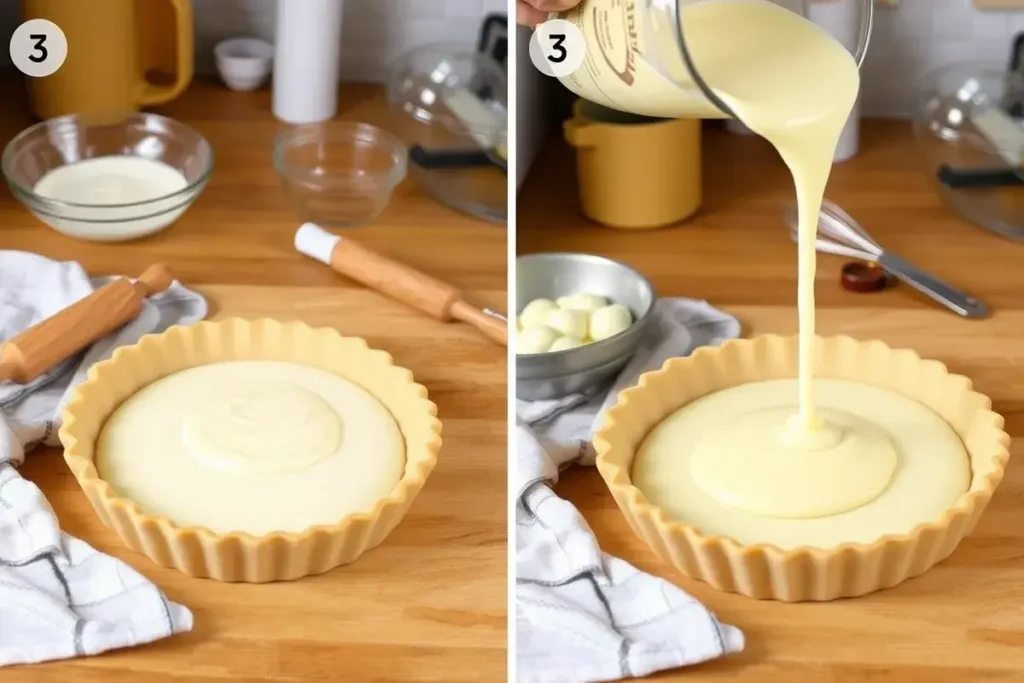
If you’ve made a homemade pie crust, make sure the edges are crimped properly so that they hold the filling securely. This step ensures that your custard stays neatly inside the pie, creating a clean and professional look when you cut into it.
Baking Time and Tips: Perfecting the Custard and Crust
Now that the custard is in the pie crust, it’s time to bake it. Place the pie in the preheated oven and bake for approximately 45-50 minutes. During this time, the custard will set and firm up while the crust turns golden brown. Here are a few baking tips to help achieve the best results:
- Check the Custard’s Doneness: To test if the custard is fully cooked, gently jiggle the pie. The custard should be firm but still slightly wobbly in the center—this is a sign it’s perfectly set. If it looks too runny, give it a few more minutes, checking every 5 minutes to avoid overbaking.
- Protect the Crust: If you notice the edges of the crust are browning too quickly, cover them with a strip of aluminum foil or a pie shield. This prevents the crust from burning while allowing the custard to continue baking.
- Even Baking: For an evenly baked pie, rotate it halfway through the baking time. This ensures both the crust and the filling cook evenly, especially if your oven has hot spots.
Cooling and Resting: Allow the Pie to Set
Once the pie has finished baking, remove it from the oven and let it cool at room temperature. Cooling is essential for the custard to firm up fully. Allow the pie to rest for at least 2 hours before slicing—this helps maintain the structure of the filling and prevents it from spilling out when cut. For an extra layer of flavor and texture, you can refrigerate the pie after it has cooled to room temperature. Chilling it for a few hours will give the custard a firmer texture, which is perfect for serving.
Tips for Serving and Storing Coconut Custard Pie
Once your coconut custard pie is baked to perfection, it’s time to think about how to serve and store it. Whether you’re serving it at a special gathering or enjoying it as a treat for yourself, these tips will ensure your pie remains fresh, delicious, and visually appealing.
Serving Suggestions:
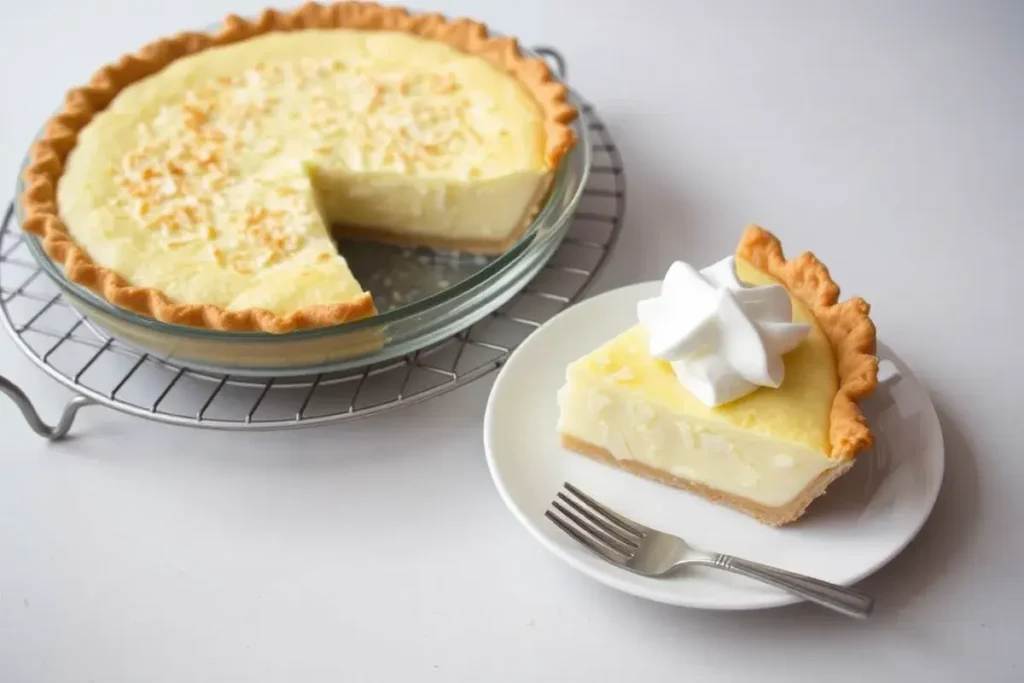
- Warm vs. Chilled: Coconut custard pie can be served both warm and chilled, depending on your preference. If you love the rich, creamy filling at room temperature, serve it chilled after letting it set in the fridge for a few hours. If you enjoy a warm, comforting dessert, allow the pie to cool slightly after baking before serving it warm. Both options offer unique textures and flavors.
- Toppings to Elevate the Flavor: To add an extra touch of flavor and texture, consider serving your coconut custard pie with a dollop of freshly whipped cream or a sprinkle of toasted coconut flakes. The coolness of whipped cream balances the warm custard, while toasted coconut adds a subtle crunch and deepens the coconut flavor.
- Pairing with Beverages: Coconut custard pie pairs beautifully with a cup of coffee, tea, or even a refreshing glass of iced lemonade. For a more indulgent treat, serve it with a scoop of vanilla ice cream to complement the creamy custard.
Storage Tips:
- Proper Cooling: After baking, let the coconut custard pie cool to room temperature before storing it. This helps prevent condensation from forming inside the storage container, which could affect the pie’s texture. If you plan to store the pie overnight, be sure to cover it loosely with plastic wrap or aluminum foil to allow air circulation while keeping it protected.
- Refrigerating Leftovers: Coconut custard pie should be stored in the refrigerator to maintain its creamy texture and prevent spoilage. Cover the pie with plastic wrap or place it in an airtight container to keep it fresh. It can be stored in the fridge for up to 3 days. If you prefer your pie chilled, this storage method also allows the flavors to meld and deepen.
- Freezing for Long-Term Storage: If you want to enjoy your coconut custard pie later, freezing is an option. To freeze, first allow the pie to cool completely, then wrap it tightly in plastic wrap followed by aluminum foil to prevent freezer burn. You can store the pie in the freezer for up to 2 months. When ready to serve, thaw the pie in the fridge overnight, and reheat it gently in the oven at a low temperature to restore its texture.
Why This Coconut Custard Pie is Perfect for Holidays:
Coconut custard pie is a versatile dessert that can be served for any occasion, but it truly shines during the holidays and special celebrations. The rich coconut flavor pairs well with other festive dishes, making it a great addition to your holiday menu. Plus, its creamy filling and golden, flaky crust make for a beautiful presentation that will impress your guests. Whether it’s Thanksgiving, Christmas, or a family birthday, this pie is sure to become a cherished tradition.
By following these serving and storage tips, you’ll ensure that your coconut custard pie remains fresh, flavorful, and ready to enjoy whenever you need a sweet treat!
conclusion
Coconut custard pie is a dessert that brings together the best of both worlds—creamy, smooth custard and the tropical sweetness of coconut—making it a treat that’s both comforting and indulgent. Whether you serve it warm with a dollop of whipped cream or chilled with toasted coconut on top, this pie is sure to delight your taste buds and impress your guests.
By following the simple steps outlined in this guide, you can easily create the best coconut custard pie from scratch. With a perfectly flaky crust, a rich, velvety filling, and tips for serving and storing it, you’ll have a dessert that’s just as delicious on day one as it is on day three. Whether it’s for a holiday celebration or just a weekend treat, this coconut custard pie will become a staple in your baking repertoire.
Try out this Coconut Custard Pie and let your creativity shine! We’d love to see your sweet creations. Tag us on Instagram at @SweetEatsRecipes and use the hashtag #CoconutCustardPie to get featured.

